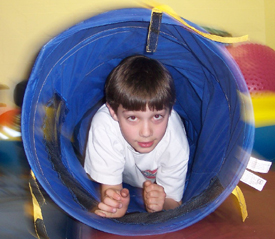
|
Pediatric Occupational, Physical, ABA/Behavioral, Feeding, Speech, and Language Therapies Main Clinic: 931-372-2567 1445 East 10th Street Cookeville, TN 38501 Email: [email protected] HIPAA Secure Email: [email protected] Fax: (931) 372-2572 ABA Clinic: 931-201-9534 400 Dubois Road Cookeville, TN 38501 Email: [email protected] Please call today to get started! Most insurances accepted! |

|
| Who needs therapy? | SE HABLA ESPAÑOL |
Occupational Therapy in Schools
What is occupational therapy?
Occupational therapy is a "..supportive service required to assist a child with a disability to benefit from special education..." Students who receive occupational therapy services in the school setting have been determined to need occupational therapy in order to benefit educationally.
Occupational therapy combines the art and science of providing and directing activities that serve to restore and enhance performance of skills needed for functional daily living. The occupational therapist uses a variety of tasks and exercises in the areas of self-care, work and play to increase functional independence, enhance development, and prevent disability. The task or the environment may be adapted to promote maximum independence and improve quality of life.
How does occupational therapy apply in the school setting?
One of a child's roles is to be successful both academically and socially in school. Some children require a modified curriculum and/or additional assistance to achieve mastery in these areas. Through the use of adaptation, teaching, therapeutic exercise and play, an occupational therapist may support a child in reaching their curriculum goals.
How does a child qualify for occupational therapy services?
1.First it must be determined that the child is eligible to receive special education services. See the PISD diagnosticians' web page for more information.
2. An Individual Education Plan (IEP) must be developed to address the academic areas of concern for the child.
3. If the child is not making progress toward mastery of the IEP goals, additional related service support may be recommended.
4. A referral is made to the occupational therapy team to evaluate the child in the school setting to determine eligibility for services.
5. An IEP meeting will be held to discuss the results of the occupational therapy evaluation. If a child does not qualify, recommendations may be made for additional assistance. The assessment report will include the recommendation for services, including goals and objectives and amount of therapy time.
What is a related service?
Related services are support services for special education and are not instructional services. They are those services necessary for the student to make progress toward the identified instructional goals. Related services may include occupational therapy, physical therapy, music therapy, assistive technology, counseling, diagnostic medical services, and transportation.
There are many "related services" that might benefit a child with a disability, just as there are many services that might benefit a child who does not have a disability. However, the law does not require that such services be provided. Rather, the legal duty to provide a related service arises only when without the service the child's educational program would become less than appropriate, i.e., when the child would not benefit from his educational program without these services. In determining whether a related service is "necessary" for a student the district should rely on a related services assessment.
(Susan B. Graham, 1996)
If a child qualifies for occupational therapy, how often will he/she receive services?
Occupational therapy services can be provided in a variety of ways as determined by the IEP committee. Based on educational needs, time may be used to work directly with the student, consult with the teaching staff or parent, and/or to address equipment/modification needs. As an example, one child may require weekly intervention to support his/her IEP goals while another child may require support once a semester to ensure that feeding and/or equipment needs are being met.
If a child is receiving private or clinical occupational therapy, will he/she automatically receive occupational therapy in the school setting?
Not necessarily. The goal of medical/clinical therapy is to treat the symptoms of the underlying cause of a child's disability. The goal of educational therapy is to assist the student in attaining educational goals. For example, in clinical therapy a child's goals may include increasing range of motion and decreasing muscle tone to improve quality of movement. In the educational environment this child's disability might not interfere with his/her ability to perform in the classroom and, therefore, he/she would not be eligible for services in the school setting.
What areas do occupational therapists address with their students in the school setting?
Fine motor skills: hand development, hand strength, grasp patterns, pencil grasp, handwriting, dexterity, scissors skills, shoulder/trunk strength and stability.
Self-help skills: manage clothing in the school setting (i.e., buttons, zippers, snaps, tie shoes), feeding skills, and use of adaptive equipment.
Oral motor skills: facilitation and desensitizationof oral structures, positioning techniques, and adaptive equipment. Sensory awareness and processing: recommend sensory strategies to optimize student's learning potential.
Why doesn't occupational therapy routinely provide services to the student on a daily basis?
Because occupational therapy is a support service, one of our main goals is to assure that the child receives recommended programs and adaptations throughout each school day. To accomplish this, the staff is trained by the occupational therapist to carry out these programs in all areas of the child's educational environment. Working together as a team, the occupational therapist and school staff are able to provide the optimum means of achieving the IEP goals. Federal law mandates that each child should be served in the least restrictive environment. This often means that the child is working daily with his/her classroom teacher on a program recommended by the occupational therapist.
Site empowered by
WebOnTheFly